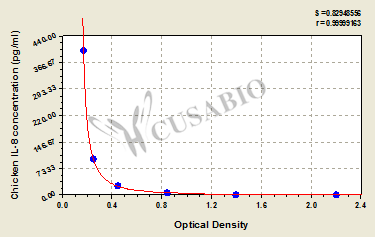Interleukin 8 (IL-8), also known as CXCL8, is a pro-inflammatory chemokine that plays a key role in immune responses and inflammation. This cytokine primarily recruits and activates neutrophils at sites of infection or tissue damage. Various cell types produce IL-8, including macrophages, epithelial cells, and endothelial cells, when exposed to inflammatory stimuli. In avian species, IL-8 serves similar functions to its mammalian counterpart. It mediates innate immune responses and contributes to the inflammatory cascade during pathogen encounters or tissue injury.
The Chicken Interleukin 8(IL-8) ELISA Kit (CSB-E14191C) is designed for quantitative measurement of interleukin 8 in Gallus gallus samples. This competitive assay works with serum, plasma, and tissue homogenates. The detection range spans 1.56 pg/mL-400 pg/mL with sensitivity of 0.78 pg/mL. The assay requires 50-100ul sample volume and can be completed within 1-5 hours. Detection occurs at 450 nm wavelength, providing researchers with a reliable tool for IL-8 quantification in chicken samples.
Application Examples
Note: The following application examples are drawn from a selection of publications citing this product. For additional applications, please refer to the full list of references in the "Citations" section.
This ELISA kit has been used in avian immunology research to quantify interleukin 8 levels in chicken biological samples. The applications span inflammatory response studies and immune system profiling in poultry research models.
• Inflammatory response studies - Measurement of IL-8 concentrations in serum and plasma samples to assess pro-inflammatory cytokine profiles during infection models and immune challenges
• Infection research - Quantification of IL-8 levels in chickens following bacterial infection to monitor inflammatory biomarker responses over time
• Immune profiling - Multi-cytokine analysis incorporating IL-8 measurements alongside other inflammatory mediators to characterize comprehensive immune responses
• Poultry immunology - Study of cytokine expression patterns in different chicken strains to understand breed-specific immune characteristics and stress responses






